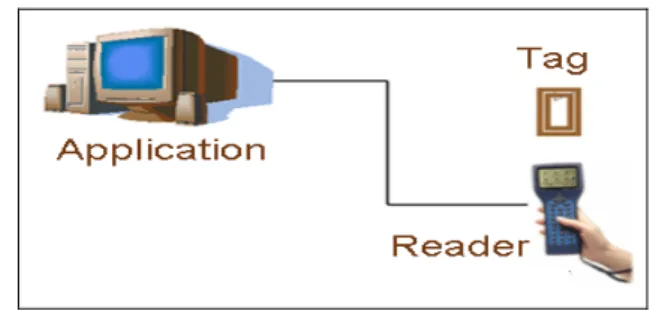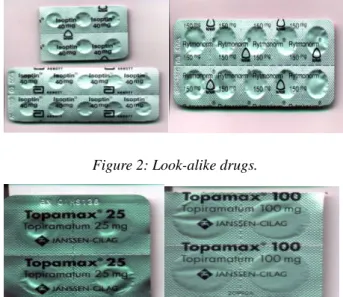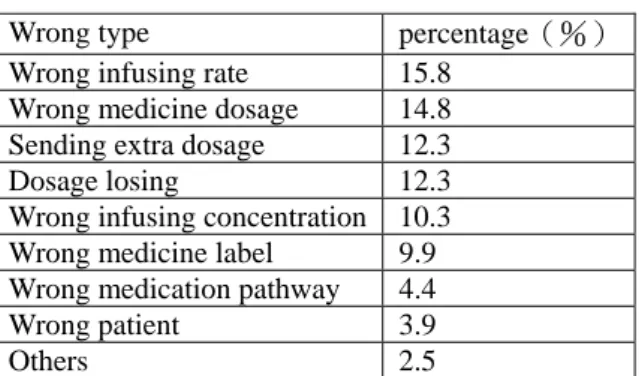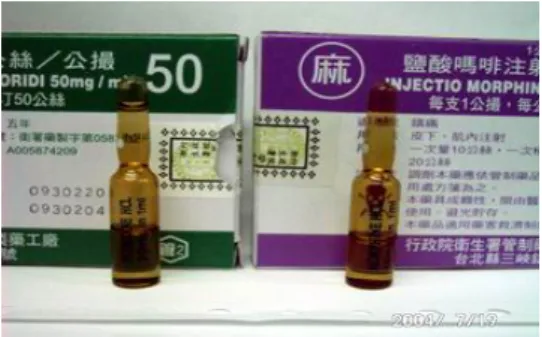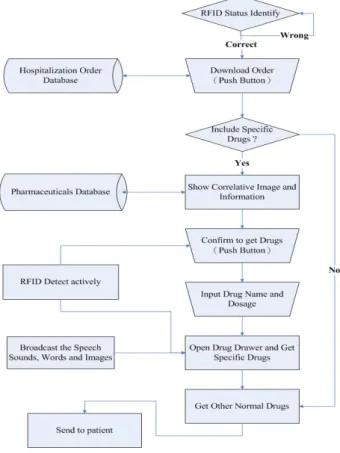The Medication Safety System Applying RFID to Improve the Safe Use and Distribution of High-Risk Drugs Chia-Hsing Hsieha, Cheng-Ju Lee
a, Li Liu
ab, Chi-Chen Wu
b
Graduate Institute of Medical Informatics, Taipei Medical University a Vice Superintendent, Taipei Medical University Hospital b
e-mail:kacos@pchome.com.tw Abstract
Today, “Medication safety” is one of the most important requirements for “patient safety”. JCAHO (Joint Commission on Accreditation of Healthcare
Organizations) also referred that the medication errors were the most common reasons among medical errors that should be prevented. Although many systems have been already applied to improve medication safety, unfortunately, human errors in the medication processes still happen. For this reason, in order to improve medication safety and reduce human errors, we present in this paper a MSS (Medication safety system) in applying RFID
(
Radio Frequency IDentification) technologies to refine the traditional checking process of“Five Rights and Three Checks safeguards” to enhance the managements of high-risk drugs. Further, this system also shows great possibility of providing extensive services for drugs control and management in whole hospital.
Keywords: RFID, Patient Safety, Medication Safety, High-Alert Medications,look-alike/sound-alike drugs Introduction:
“Medication safety" is one of the most important issues for “patient safety". Especially, the medication errors taken place in the Women's and Children's Hospital, Tucheng City and Chong-Ai dispensary, Pingtung County in recent years, have caused deaths and injuries. Such incidents remind us how important the improvement must be carefully and continuously proceeded. With the advanced developments of technology, Healthcare Information Systems (HIS) has been developed for twenty years in Taiwan. In the early stages, what the hospital administrative needed for HIS
were the basic functions. (Ex
:
register, charge, accounts at a hospital, etc.). Gradually, it has expanded the decision support systems and clinical healthcares. (Ex:Medical Decision Support System, Clinical Information System, Electronic Patient Record, etc.) HIS provides warnings and suggestions for healthcare professionals to reduce medical errors [10]. The development of medication information system (MIS) is also similar to HIS. In order to reduce the mistakes in pharmacy for taking medicine, improve the quality of medication and decrease the waiting time, some mechanisms like prescription delivering system, Unite Does Distribution System (UDDS) and drug interaction alarm system, etc.
were developed for MIS.
RFID(Radio-Frequency Identification)
RFID doesn’t require the line of sight touch and is an automatic identification system by using Radio frequency wave. In general, RFID system composed of three parts: Tags, Reader and application. (Figure 1) Depends on usage of battery or not, tags are divided into two types: active tag and passive tag. Passive tags receive energy of electromagnetic field from readers and transform the energy into electric power. Its advantage is small, cheap, portable and long lifespan.
Figure 1: RFID Layout (From: www.rfidasia.com/
htmdocs/rfid_systems/systems.htm)
A RFID system includes tags that carry data in suitable
transponders and a RFID reader retrieves the data from the tags. The data is written to the RFID tag enabling to identify and characterize an object with a specific application. A RFID reader scans and acknowledges the information from RFID tags when they are within range of an electromagnetic field and to perform a user-defined functionality. With the development of RFID, it can be widely used in different domains such as air package control, automatic production management, warehouse management, transportation monitoring, security control, library management and healthcare management, etc. [3, 15]. We also use RFID technologies in our daily lives such as Taipei MRT tickets, wireless entrance guard card, store anti-theft sensor etc.
JCAHO had referred that the medication errors were the mostly common reasons of medical errors that should be prevented. If we can use a medication safety system applying RFID technologies with health-care workers or patients identification cards and HIS to achieve the goals of: 1) enhance the medication safety, 2) implement management procedures, 3) promote management efficiency, 4) saving human resources, it will be also much helpful to know what the patient has to take at when, how, where to take and served by whom.
Therefore, in this study, we will design a Medication safety system for high-risk drugs to “improve the accuracy of patient identification" and “improve the safety of using medications". As soon as the cost of RFID components will be reduced, we expect this system will be extensive to apply for all drugs and sanitary materials.
Literature Review:
JCAHO approved the 2005 National Patient Safety Goals (NPSGs) at its July meeting in 2004. Among the seven goals of NPSGs announced about hospital,
“improve the accuracy of patient identification” and
“improve the safety of using medications” are the key points of medication safety improvement. Especially for
“improve the safety of using medications”, there are some new requirements:
” Identify and, at a minimum, annually review a list of look-alike/sound-alike drugs used in the organization, and take action to prevent errors involving the interchange of these drugs” [11, 17].
In Europe and USA, there were several large epidemiological studies where we receive a roughly estimation. There are 3.8% of hospital patients subjected to MAE (Medical Adverse Events). Among those events, 27.6% of MAE was judged as negligence. For all of those MAE, half of them were related with operation (48%), 19% with drugs, 14% with infection and 13%
with technique. In those MAE that associated with drugs, most of them were dispensing errors (Ex: wrong form of a drug, dosage or frequency etc.) or checking errors (Ex:
wrong drug, number or patient etc.) except parts of drug interactions [2]. However, we can find that one of the fundamental reasons is “human errors". Because of many drugs are look-alike or sound-alike, it is easy to make mistakes by health-care professionals. (Figure 2, 3)
Figure 2: Look-alike drugs.
Figure 3: The same drugs but different dosage.
Now, when a patient goes to see a doctor or to be hospitalized, many procedures of HIS (Ex: prescription transmitting system, drug interaction alarm system) can reduce the human errors till an order is completed. But the processes from pharmacy receiving order to patient taking drugs, there are many details must to be checked by human. For example: three checks and five rights of
drugs by pharmacist and nurse. This procedure of this part is easy to cause human errors. In March 2003, there was a study at a region hospital in Sansia Township, Taipei County that used a check table to monitor nurses to distribute medicines. The result showed the correction rate was 83% and the factors of less correction were: 1) check the order correctly. 2) execute “three checks and five rights" correctly. 3) recognition and understanding of drugs [12]. From 1994 to 1999, Ross's study at a large children hospital in England showed that: Total medication error rate was 0.15%. The major error was
“Wrong infusing rate" (15.8%). Second was “Wrong medicine dosage" (14.8%). Others like “Wrong medicine label" and “Wrong patient" were 9.9% and 3.9% (Table 1) [19, 20, 21].
Table 1: Ross's study about the reasons of major medication errors.
Wrong type percentage(%)
Wrong infusing rate 15.8 Wrong medicine dosage 14.8 Sending extra dosage 12.3
Dosage losing 12.3
Wrong infusing concentration 10.3 Wrong medicine label 9.9 Wrong medication pathway 4.4
Wrong patient 3.9
Others 2.5 Although patient safety promotion never interrupted in all medication environment but unpreventable human interferences and errors still reflect certain proportion and reduce the efforts of promotion. For this reason, the major objective of this study is to apply RFID technologies and their characteristic of automatic identification to reduce the human errors [3]. The purpose of this study is to construct a RFID medication safety system for high-risk drugs to reduce the human errors in the existing medication check processes. This study can promote the check correction rate of nurse. It also helps us to check the order correctly, execute
“three checks and five rights" correctly, and enhance the recognition and understanding of drugs. It can reduce the percentage of medication error in Ross's study about wrong medication dosage, wrong medicine label,
wrong medication pathway and wrong patient etc.
Material and Method:
In this study, to reduce the medication errors, we design a pilot study for high-risk drugs in the hospital of north Taiwan where we use active RFID tags to identify medical personnel and patients, and use passive RFID tags adhered to injection needles to identify controlled medication. At the same time, we also apply voice and image to integrate with current clinical information system to enhance the three checks (read from medication package, read item from medication package and returned left medication back to box) and five rights (right patient, right time, right drugs, right route and right dose) from current process.
Material
The RFID architecture we've designed in this study including Tag, reader and application system. Also, the voice and a medication container are applied for this architecture. To make the study easier to be realized, we take the Demerol and Morphine which are the most confusing from appearance for medical personnel as controlled drugs examples (Figure 4). Here are the components of architecture as below:
(1)Tag:
According to the frequency band (Hz), the most commonly used of RFID system are classified as 0-135KHz, 6.78MHx of ISM frequency band, 13.56MHX, 27.125MHz, 40.6Mhz, 433.92MHz, 916.5MHz, 2.45GHz, 5.8GHz and 24.125GHZ etc. In this study, medical personnel and patients use active tag adhere to their ID cards that the tags are able to store data from 48 bytes to 8kbytes, depends on how much data need to be stored in tags. The wake up frequency is 433 MHz, reading coverage was set from 3 to 85 meters.
(2)Reader:
Including one real-time processor and operating system where the memory is 10 Megabits, the interface of transmission is RS232 to RJ11, operating frequency from tag is 916.5 MHz, tag's wake up frequency is
433 MHz, reading coverage is from 3 to 85 meters also can read at the same time more than 50 tags per second.
(3)Application System:
The computer capacity is Intel Pentium III 1G CPU with 512MB memory and 40GB H/D, Windows 2000 OS, and we use VB6.0 as the tool of applications development.
Figure 4.: Left is Demerol;Right is Morphine.
Method
The characteristics of this study are:
(1)Use both active and passive tags:
Use active tags adhered to ID cards for medical personnel and patients;passive tags for high-risk drugs to ensure the confirmation of “Right patient" and
“Right medication".
(2)Medication container with voice notification:
Use RFID system on medication container where store the controlled medications to ensure firstly the right prescription of patient, this container will be unlocked and opened automatically by system. Secondly, RFID tags will detect automatically if the drugs being taken away are correct or not and system will deliver voice message to reconfirm this process.
(3)Audiovisual reminding mechanism with voice and image:
In this system, to enhance the current checking process of five rights, we design a double reminding mechanism and use the voice message to broadcast necessary reminding notification and also, system shows the image of drug on screen simultaneously.
(4)Connect to Clinical Information System:
This system is integrated with hospital's clinical
information system. User can download the order to confirm and send query for further reconfirmation.
When system starts, RFID tag detects automatically the ID card of medical personnel and asks him/her to key in account number and pin code to ensure the user identification. As soon as system reconfirm user’s identification, system shows user’s picture on the computer screen and broadcast the time, user’s name and title and to remind necessary process and details by voice. For next step, use similar process and patient’s ID card to confirm patient’s identification.
In addition, after the identification of user and patient, system connects to clinical information system and downloads automatically patient's order. System will identify simultaneously drug's information with database and show immediately the picture of drug as well. When medical personnel confirm to take away the controlled drug from medication container, system will ask him/her to key in drug's name and dose to double reconfirm. For any mistakes during this process, system will deliver vocal message for correction. As long as each confirmation is appropriately done, system will then open automatically the medication container. Also, in the meantime, system will detect and identify if the drug taken by medial personnel is matched to the prescription and if not, system will deliver again the vocal message to remind such mistakes. When the drug taken away and is confirmed, system sends again the vocal message to reconfirm the drug's name, dose, time, route and how to use the drug , and, the drug's image will be shown on the screen for double confirm to avoid any negligent errors. More than the application for controlled drugs, same process can be used for generic medication. Here below is the flow of system as figure 5.
Figure 5: System Flow Result:
From our study, we found that the errors like giving the wrong drugs, wrong doses, wrong patients and wrong routes made by human during the process of three checks and five rights have been dramatically reduced after the implementation of the system. This system also helps medical personnel to reconfirm orders, correctly execute the three checks and five rights to improve the accuracy of using high-risk drugs and patient safety.
In this study, we take the easiest mistaken drugs - Demerol and Morphine (figure 4) - as the examples of high-risk drugs for system, here are the user interface of system as below (figure 6-9):
Figure 6: System confirm automatically the nurse's ID
Figure 7: Nurse log-in to access patient's ID and download order
Figure 8: Reconfirm controlled drugs in prescription
Figure9: Reconfirm drugs name, appearance, dose etc.
According to the publication of Taiwan National Bureau of Controlled Drugs, the statistics shown that malpractice of controlled drugs among pharmacies when Bureau’s on-site auditing from 2002 to 2003, the majority of malpractice came from incorrect information in record book, others like: lacked of record book for balance of controlled drugs, didn’t follow the regulations to declare the balance of controlled drugs, controlled drugs were used by non-medical persons and used the 1st to 3rd controlled drugs without regulated prescription and so on. Nevertheless, the system in this study can be integrated with hospital’s inventory system to improve the quality of controlled drugs management [14].
Conclusion and Discussion:
Use RFID tags to identify accurately appearance, packaging, size or even similar names of drugs can meet the goals of “Improve the accuracy of patient identification" and “Improve the safety of using medications" approved by JCAHO for year 2005. In addition, the medication errors can be also reduced by audiovisual reminding mechanism of system. Further with the integration of HIS, system provides more complete medical information for people who offer healthcare services to patients.
Based on the ideal of “Patient Centric", we expect in the near future to develop more functionalities for this system and also, can integrate with handheld devices to extend application from workstation to bedside.
However, the cost of RFID system is still a barrier for wider applications. But we do believe, as soon as the cost of RFID system can be reduced to the similar level of bar code system, instead of the single medication container or workstation as demonstrated in our study, there will be more useful applications and services like for hospital-wide inventory management can be explored Reference:
1. 王德忠,黃昭棋,陳英一 (2004) ,RFID 發展趨 勢與 EPC 應用現況,p1-p9。
2. 石崇良 (2004) ,認識病人安全,財團法人醫院 評鑑暨醫療品質策進會。
http://www.tjcha.org.tw/safe/safe01.asp 3. 吳啟誠 MD,MBA (2004) ,『RFID 簡介及其在醫
療產業的應用』演講稿。
4. 唐菁華 (2003) ,某地區教學醫院異常處方之分析 與探討,藥學雜誌第十九卷第一期之二,p109-
p124。
5. 唐慧文,John Carroll (2004) ,神奇的 RFID,
http://taiwan.cnet.com。
6. 張基平,曾建榮 (2003) ,RFID 晶片讓教學玩具 變聰明了,技術尖兵第 097 期 92 年 01 月號,經 濟部技術處。
7. 條碼識別,射頻識別 (2004) ,商業流通資訊 2004 March 季刊 p13-p36。
8. 陳秀梅博士 (2004) ,RFID 國際標準簡介及台灣
之對策,http://www.can.org.tw/2004-03_6.htm,p13
-p20。
9. 陳美華,陳美珠,邱淑慧 (2004) ,以病人為中心 之安全醫療照護給藥之辨識,第二屆台灣醫療品 質促進年會。
10. 湯進聖 (2002) ,醫院醫囑藥物交互作用提示系 統,國立陽明大學公共衛生研究所,碩士論文。
11. 曾慧萍摘譯 (2004) ,2004 年 JCAHO 病人安全 目標,
http://ttw3.mmh.org.tw/qcc/download/safe.h tm。
12. 黃嬿蓉,林家惠,鄭瓊姿,藍玉芬 (2004) ,提 升某區域醫院外科病房護理人員對住院病患的給 藥正確率,第二屆台灣醫療品質促進年會。
13. 劉 曾 茂 (2004) , 隨 著 科 技 的 脈 動 逐 步 轉 化
Barcode 進 入 RFID 領 域 ,
http://www.can.org.tw/2004-03_6.htm,p1-p12。
14. 行 政 院 衛 生 署 管 制 藥 品 管 理 局 http://www.nbcd.gov.tw/aud/aud_1-04.asp
15. 經 濟 部 技 術 處 全 球 資 訊 網
http://www.jah.org.tw/chinese/4_activities/1_news/n ews/2003/1222.asp
16. Cheng-Ju Lee, Li Liu, Shi-Zong Chen, Chi Chen Wu, Chun-Huang Huang, Xin-Mei Chen (2004) , Mobile Healthcare Service System Using RFID IEEE 2004 ICNSC.
17. JCAHO 2005 Hospital National Patient Safety Goals (2004)
http://www.jcaho.org/accredited+organizations/patie nt+safety/05+npsg/05_npsg_hap.htm.
18. Lesar TS. et al., Stein DS. (1997) , Factors related to errors in medication prescribing, JAMA, 277 (4), p312-p317.
19. Mark Rosenbloom, MD., MBA., FACEP. (2003) , Medical Error Reduction and PDAs, International Pediatrics Vol. 18 No. 2.
20. Paton J., Wallace J. (1997) , Medication errors, Lancet, 349(9056), p959-p960.
21. Ross LM. Et al. (2000), Medication errors in a paediatric teaching hospital in the UK.: five years operational experience.Archives of Disease in Childhood, 83(6): p492-p497.
